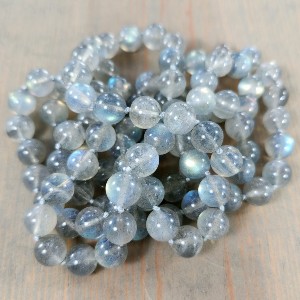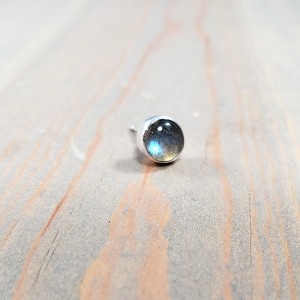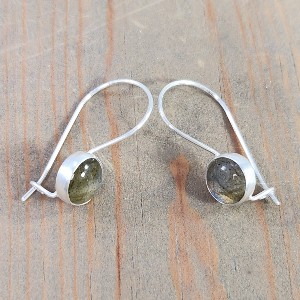Don’t you love labradorite? There are so many colors from almost clear to gray, green and blue – and, of course, that beautiful blue flash. It’s always been one of my best sellers so I thought I’d share some information about this mesmerizing stone.
What is Labradorite?
 Labradorite is a type of feldspar mineral known for its stunning optical phenomenon called labradorescence. This phenomenon causes the stone to display a brilliant array of colors that shift depending on the angle of the light. Colors such as blue, green, gold, and even hints of purple can appear on the surface, giving it a gorgeous iridescence. This play of color is the result of light being refracted within the layers of the stone.
Labradorite is a type of feldspar mineral known for its stunning optical phenomenon called labradorescence. This phenomenon causes the stone to display a brilliant array of colors that shift depending on the angle of the light. Colors such as blue, green, gold, and even hints of purple can appear on the surface, giving it a gorgeous iridescence. This play of color is the result of light being refracted within the layers of the stone.
Labradorite is classified as a silicate mineral and is commonly found in igneous rocks, such as basalts and gabbros, where it forms in the cooling stages of molten magma. While labradorite can come in a variety of colors, most people look for the vivid blues and greens that can evoke a sense of depth and mystery.
Where is Labradorite Found?
Labradorite gets its name from the Labrador Peninsula in Canada where it was first discovered in the 18th century. However, this mineral is found in a variety of locations across the globe, making it accessible for use in jewelry. Major sources of labradorite include:
- Canada: Particularly the Labrador Peninsula, which remains a key source of high-quality stones.
- Madagascar: Known for producing vibrant specimens with an intense range of colors.
- Norway: Another prominent source, producing labradorite with unique hues and variations.
- Russia: Known for both high-quality and abundant deposits.
- India: Also, a significant producer of labradorite, often used in cabochon cuts for jewelry.
Spiritual Meanings and Properties of Labradorite
 Labradorite is not only prized for its beauty, but also for its spiritual significance to practitioners who believe labradorite has powerful metaphysical properties:
Labradorite is not only prized for its beauty, but also for its spiritual significance to practitioners who believe labradorite has powerful metaphysical properties:
- Energy and Protection: Labradorite is thought to act as a shield against negative energies. It is said to protect the wearer by creating a barrier that deflects unwanted influences.
- Spiritual Awakening: This gemstone is often associated with enhancing intuition and spiritual insight. Many believe it helps awaken one's inner wisdom and allows access to higher realms of consciousness.
- Creativity and Inspiration: Labradorite is also considered a stone of creativity, helping to ignite fresh ideas and innovative thinking. It is said to encourage the wearer to embrace new possibilities and break through mental barriers.
- Emotional Healing: Labradorite is believed to help balance the emotions and heal past wounds or emotional distress.
Many spiritual practitioners, including healers and those who practice crystal therapy, often use labradorite for its transformative qualities. Wearing it or keeping it nearby is thought to help align one’s energy with a higher purpose and foster personal growth.
Mineral Information and Durability
Labradorite is a fairly durable gemstone, ranking between 6 to 6.5 (out of 10) on the Mohs scale of hardness. While it is not as hard as diamonds or sapphires, labradorite is still suitable for everyday wear, though it requires some care to avoid scratching or chipping. It is best to store labradorite jewelry separately from harder gemstones and to avoid contact with harsh chemicals or abrasives.
Labradorite's cleavage is perfect, meaning that it can split along natural lines, so caution should be taken when setting the stone to avoid fractures. Proper care includes gentle cleaning with a soft cloth and avoiding ultrasonic cleaners or steam cleaning.
Conclusion
 Labradorite has aesthetic beauty, spiritual significance, and geological intrigue. Whether you want to enhance your spiritual intuition or simply add a touch of beauty to your jewelry collection, labradorite is a great choice.
Labradorite has aesthetic beauty, spiritual significance, and geological intrigue. Whether you want to enhance your spiritual intuition or simply add a touch of beauty to your jewelry collection, labradorite is a great choice.
